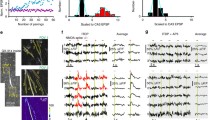Abstract
Synaptic strength is modified by the temporal coincidence of synaptic inputs without back-propagating action potentials (BPAPs) in CA1 pyramidal neurons. In order to clarify the interactive mechanisms of associative long-term potentiation (LTP) without BPAPs, local paired stimuli were applied to the dendrites using high-speed laser uncaging stimulation equipment. When the spatial distance between the paired stimuli was <10 micrometer, nonlinear amplification in excitatory postsynaptic potential summation was observed. In the time window from −20 to 20 ms, supralinear amplification was observed. Supralinear amplification was modulated by antagonist of voltage-gated Na+/Ca2+ channels and NMDA-type glutamate receptors. These results are closely related to the spatiotemporal-characteristics of associative LTP without BPAPs. This study proposes an essential aspect of dendritic information processing.






Similar content being viewed by others
References
Aihara T, Abiru Y, Yamazaki Y, Watanabe H, Fukushima Y, Tsukada M (2007) The relation between spike-timing dependent plasticity and Ca2+ dynamics in the hippocampal CA1. Neuroscience 145:80–87
Bi G, Poo M (1998) Synaptic modifications in cultured hippocampal neurons; dependence on spike timing, synaptic strength, and postsynaptic type. J Neurosci 18:10464–10472
Bi G, Poo M (2001) Synaptic modification by correlated activity: Hebb’s postulate revisited. Annu Rev Neurosci 24:139–166
Cash S, Yuste R (1999) Linear summation of excitatory inputs by CA1 pyramidal neurons. Neuron 22(2):383–394
Dan Y, Poo MM (2006) Spike timing-dependent plasticity: from synapse to perception. Physiol Rev 86:1033–1048
Froemke RC, Poo MM, Dan Y (2005) Spike-timing-dependent synaptic plasticity depends on dendritic location. Nature 434(7030):221–225
Gasparini S, Magee JC (2006) State-dependent dendritic computation in hippocampal CA1 pyramidal neurons. J Neurosci 26(7):2088–2100
Gasparini S, Migliore M, Magee JC (2004) On the initiation and propagation of dendritic spikes in CA1 pyramidal neurons. J Neurosci 24(49):11046–11056
Gasparini S, Losonczy A, Chen X, Johnston D, Magee JC (2007) Associative pairing enhances action potential back-propagation in radial oblique branches of CA1 pyramidal neurons. J Physiol 580:787–800
Golding NL, Staff NP, Spruston N (2002) Dendritic spikes as a mechanism for cooperative long-term potentiation. Nature 418(6895):326–331
Hebb DO (1949) The organization of behavior. John Wiley, New York
Hestrin S, Sah P, Nicoll RA (1990) Mechanisms generating the time course of dual component excitatory synaptic currents recorded in hippocampal slices. Neuron 5(3):247–253
Hille B (2001) Ion channels of excitable membrane, 3rd edn. Sinauer, Sunderland
Hoffman DA, Magee JC, Colbert CM, Johnston D (1997) K+ channel regulation of signal propagation in dendrites of hippocampal pyramidal neurons. Nature 387(6636):869–875
Huang YY, Pittenger C, Kandel ER (2004) A form of long-lasting, learning-related synaptic plasticity in the hippocampus induced by heterosynaptic low-frequency pairing. Proc Natl Acad Sci USA 101(3):859–864
Kojima H, Simburger E, Nakai J, Boucsein C, Maruo T, Tsukada M, Okabe S, Aertsen Ad (2006) Development of a system for patterned rapid photolysis and 2-photon confocal microscopy. Circuit Device Mag IEEE 22(6):66–74
Lester RA, Clements JD, Westbrook GL, Jahr CE (1990) Channel kinetics determine the time course of NMDA receptor-mediated synaptic currents. Nature 346(6284):565–567
Magee JC, Cook EP (2000) Somatic EPSP amplitude is independent of synapse location in hippocampal pyramidal neurons. Nat Neurosci 3:895–903
Magee JC, Johnston D (1997) A synaptically controlled, associative signal for Hebbian plasticity in hippocampal neurons. Science 275(5297):209–213
Markram H, Lübke J, Frotscher M, Sakmann B (1997) Regulation of synaptic efficacy by coincidence of postsynaptic APs and EPSPs. Science 275(5297):213–215
Nishiyama M, Hong K, Mikoshiba K, Poo MM, Kato K (2000) Calcium stores regulate the polarity and input specificity of synaptic modification. Nature 408(6812):584–588
Remy S, Csicsvari J, Beck H (2009) Activity-dependent control of neuronal output by local and global dendritic spike attenuation. Neuron 61(6):906–916
Stuart GJ, Häusser M (2001) Dendritic coincidence detection of EPSPs and action potentials. Nat Neurosci 4(1):63–71
Tsukada M, Pan X (2005) The spatiotemporal learning rule and its efficiency in separating spatiotemporal patterns. Biol Cybern 92(2):139–146
Tsukada M, Aihara T, Saito H, Kato H (1996) Hippocampal LTP depends on spatial and temporal correlation of inputs. Neural Netw 9:1357–1365
Tsukada M, Aihara T, Kobayashi Y, Shimazaki H (2005) Spatial analysis of spike-timing-dependent LTP and LTD in the CA1 area of hippocampal slices using optical imaging. Hippocampus 15:104–109
Tsukada M, Yamazaki Y, Kojima H (2007) Interaction between the spatio-temporal learning rule (STLR) and Hebb type (HEBB) in single pyramidal cells in the hippocampal CA1 area. Cogn Neurodyn 1:1157–1167
Watanabe S, Hoffman DA, Migliore M, Johnston D (2002) Dendritic K+ channels contribute to spike-timing dependent long-term potentiation in hippocampal pyramidal neurons. Proc Natl Acad Sci USA 99(12):8366–8371
Acknowledgments
This work was supported by the 21st Century and the Global COE Program at Tamagawa University and Grant-in-Aid for Scientific Research 17021036, 19200014, 21120006 from Ministry of Education, Culture, Sports, Science and Technology of Japan.
Author information
Authors and Affiliations
Corresponding author
Rights and permissions
About this article
Cite this article
Yoneyama, M., Fukushima, Y., Tsukada, M. et al. Spatiotemporal characteristics of synaptic EPSP summation on the dendritic trees of hippocampal CA1 pyramidal neurons as revealed by laser uncaging stimulation. Cogn Neurodyn 5, 333–342 (2011). https://doi.org/10.1007/s11571-011-9158-9
Received:
Revised:
Accepted:
Published:
Issue Date:
DOI: https://doi.org/10.1007/s11571-011-9158-9




